Critical Appraisal of a RCT on PIVC Failure: Emergency Department
VerifiedAdded on 2021/06/17
|14
|3492
|49
Report
AI Summary
This report offers a critical appraisal of a randomized controlled trial (RCT) investigating the efficacy of skin glue adhesives compared to standard catheter care in minimizing peripheral intravenous catheter (PIVC) failure in emergency departments. The critique examines the study's introduction, title, abstract, literature review, research design, sample, data collection, data analysis, results, and conclusions. The study, conducted in an Australian hospital, aimed to determine if skin glue could reduce PIVC failure rates. The report analyzes the study's methodology, including its quantitative design, hypothesis, sample selection, data collection methods, and statistical analysis. The findings indicated that the use of skin glue adhesives resulted in a significantly lower PIVC failure rate and reduced catheter dislodgement. The report also discusses the study's relevance to nursing practice, emphasizing the importance of evidence-based care and the potential of the findings to improve patient outcomes and reduce healthcare costs. The author provides a balanced evaluation, highlighting both the strengths and limitations of the study and its implications for clinical practice.
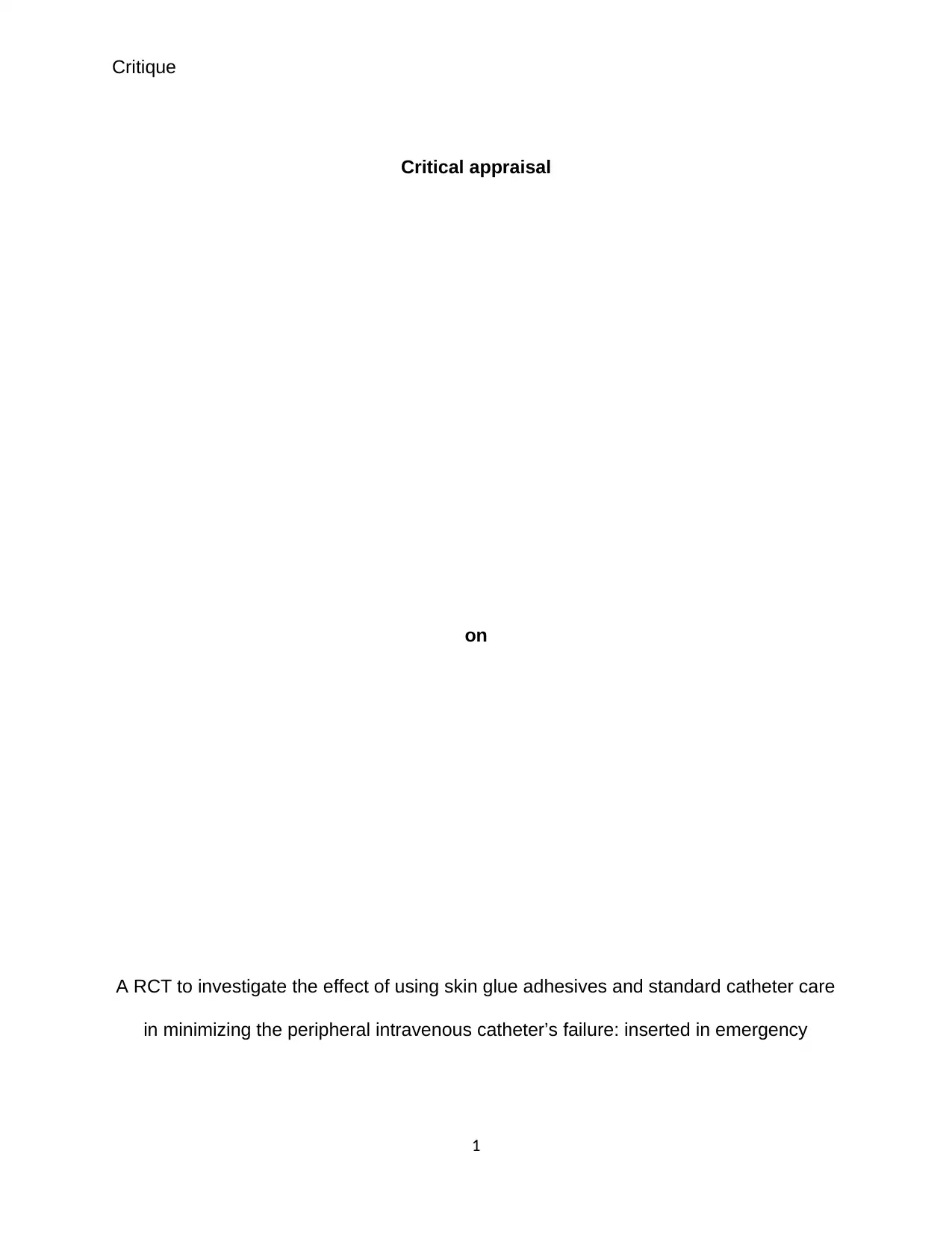
Critique
Critical appraisal
on
A RCT to investigate the effect of using skin glue adhesives and standard catheter care
in minimizing the peripheral intravenous catheter’s failure: inserted in emergency
1
Critical appraisal
on
A RCT to investigate the effect of using skin glue adhesives and standard catheter care
in minimizing the peripheral intravenous catheter’s failure: inserted in emergency
1
Paraphrase This Document
Need a fresh take? Get an instant paraphrase of this document with our AI Paraphraser
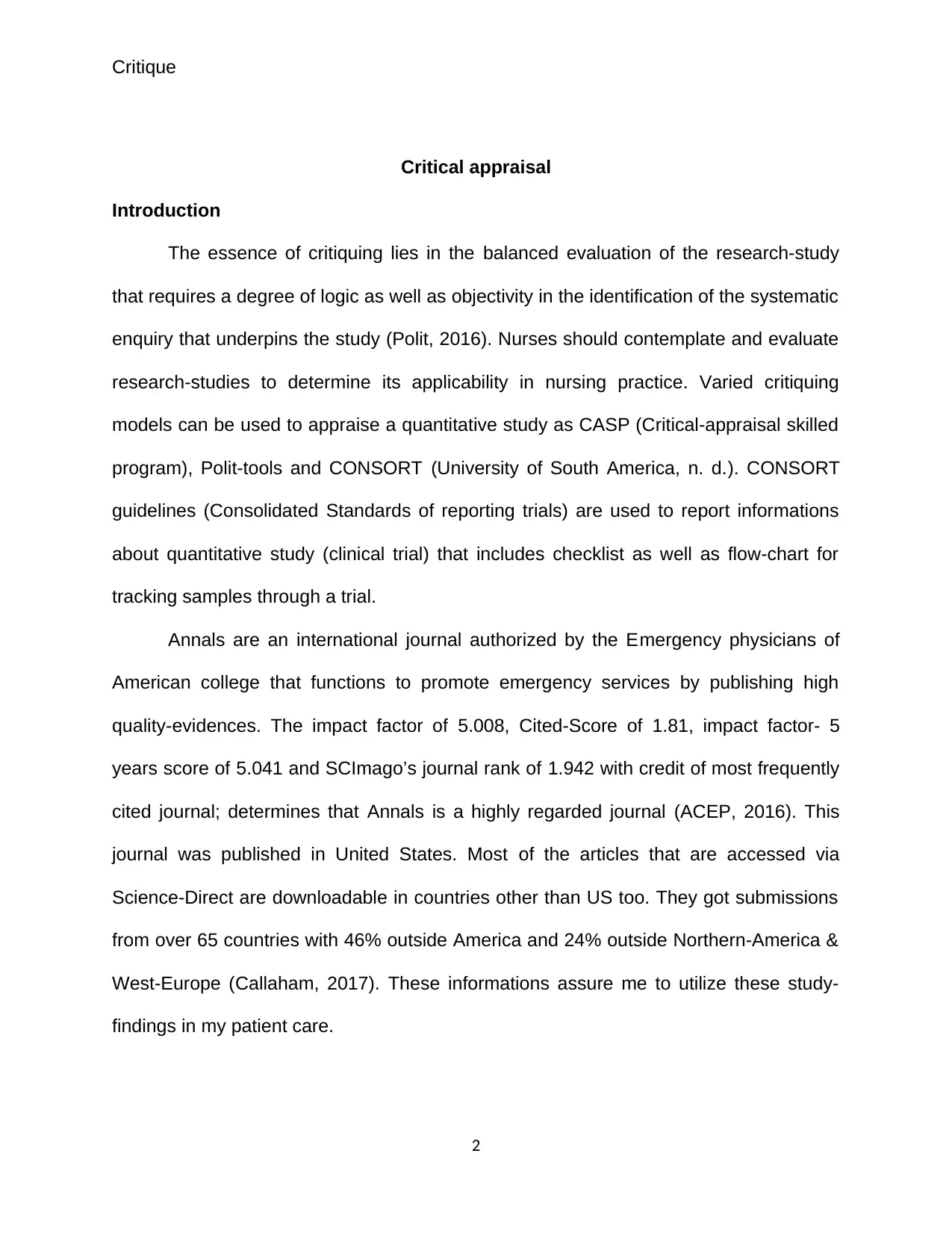
Critique
Critical appraisal
Introduction
The essence of critiquing lies in the balanced evaluation of the research-study
that requires a degree of logic as well as objectivity in the identification of the systematic
enquiry that underpins the study (Polit, 2016). Nurses should contemplate and evaluate
research-studies to determine its applicability in nursing practice. Varied critiquing
models can be used to appraise a quantitative study as CASP (Critical-appraisal skilled
program), Polit-tools and CONSORT (University of South America, n. d.). CONSORT
guidelines (Consolidated Standards of reporting trials) are used to report informations
about quantitative study (clinical trial) that includes checklist as well as flow-chart for
tracking samples through a trial.
Annals are an international journal authorized by the Emergency physicians of
American college that functions to promote emergency services by publishing high
quality-evidences. The impact factor of 5.008, Cited-Score of 1.81, impact factor- 5
years score of 5.041 and SCImago’s journal rank of 1.942 with credit of most frequently
cited journal; determines that Annals is a highly regarded journal (ACEP, 2016). This
journal was published in United States. Most of the articles that are accessed via
Science-Direct are downloadable in countries other than US too. They got submissions
from over 65 countries with 46% outside America and 24% outside Northern-America &
West-Europe (Callaham, 2017). These informations assure me to utilize these study-
findings in my patient care.
2
Critical appraisal
Introduction
The essence of critiquing lies in the balanced evaluation of the research-study
that requires a degree of logic as well as objectivity in the identification of the systematic
enquiry that underpins the study (Polit, 2016). Nurses should contemplate and evaluate
research-studies to determine its applicability in nursing practice. Varied critiquing
models can be used to appraise a quantitative study as CASP (Critical-appraisal skilled
program), Polit-tools and CONSORT (University of South America, n. d.). CONSORT
guidelines (Consolidated Standards of reporting trials) are used to report informations
about quantitative study (clinical trial) that includes checklist as well as flow-chart for
tracking samples through a trial.
Annals are an international journal authorized by the Emergency physicians of
American college that functions to promote emergency services by publishing high
quality-evidences. The impact factor of 5.008, Cited-Score of 1.81, impact factor- 5
years score of 5.041 and SCImago’s journal rank of 1.942 with credit of most frequently
cited journal; determines that Annals is a highly regarded journal (ACEP, 2016). This
journal was published in United States. Most of the articles that are accessed via
Science-Direct are downloadable in countries other than US too. They got submissions
from over 65 countries with 46% outside America and 24% outside Northern-America &
West-Europe (Callaham, 2017). These informations assure me to utilize these study-
findings in my patient care.
2
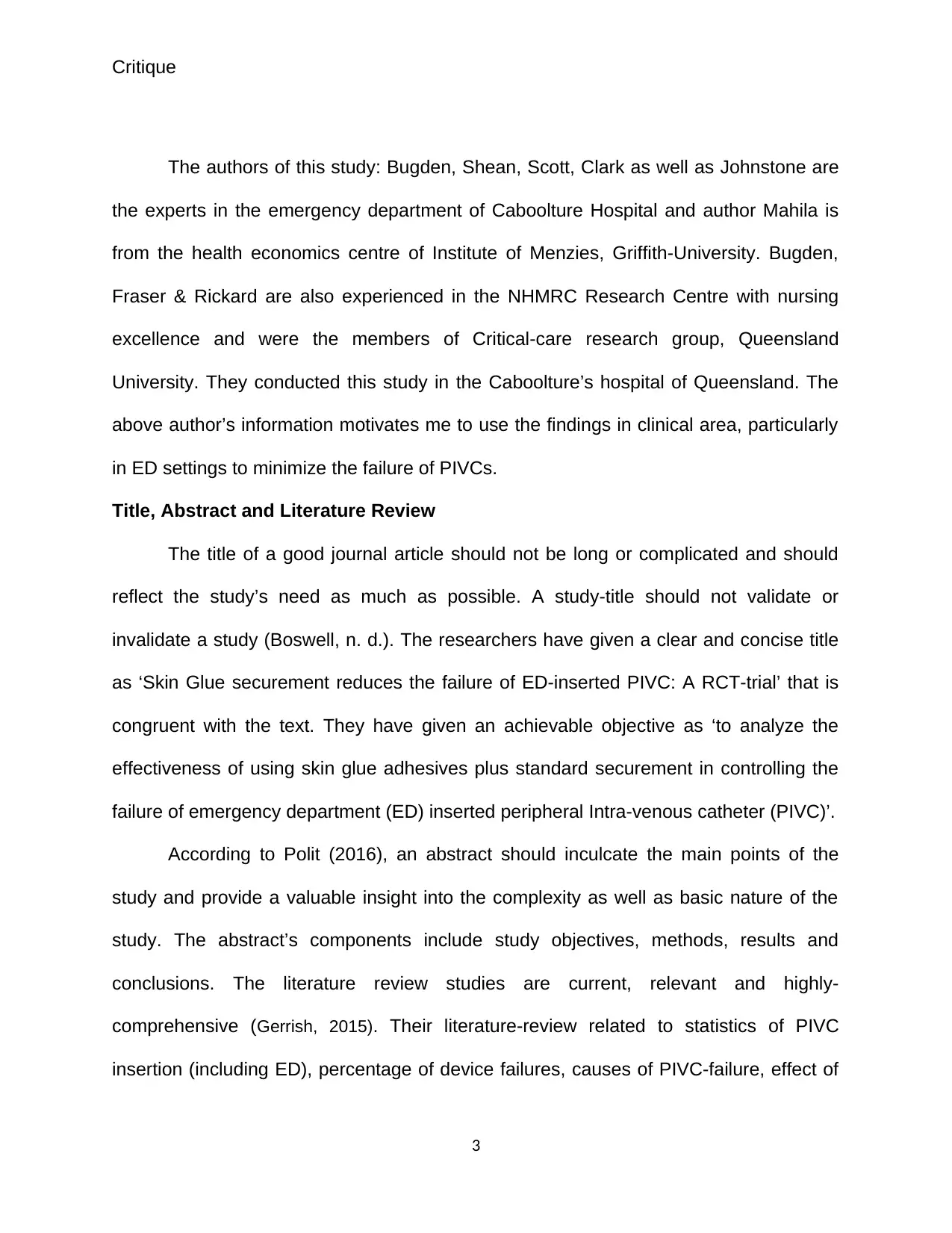
Critique
The authors of this study: Bugden, Shean, Scott, Clark as well as Johnstone are
the experts in the emergency department of Caboolture Hospital and author Mahila is
from the health economics centre of Institute of Menzies, Griffith-University. Bugden,
Fraser & Rickard are also experienced in the NHMRC Research Centre with nursing
excellence and were the members of Critical-care research group, Queensland
University. They conducted this study in the Caboolture’s hospital of Queensland. The
above author’s information motivates me to use the findings in clinical area, particularly
in ED settings to minimize the failure of PIVCs.
Title, Abstract and Literature Review
The title of a good journal article should not be long or complicated and should
reflect the study’s need as much as possible. A study-title should not validate or
invalidate a study (Boswell, n. d.). The researchers have given a clear and concise title
as ‘Skin Glue securement reduces the failure of ED-inserted PIVC: A RCT-trial’ that is
congruent with the text. They have given an achievable objective as ‘to analyze the
effectiveness of using skin glue adhesives plus standard securement in controlling the
failure of emergency department (ED) inserted peripheral Intra-venous catheter (PIVC)’.
According to Polit (2016), an abstract should inculcate the main points of the
study and provide a valuable insight into the complexity as well as basic nature of the
study. The abstract’s components include study objectives, methods, results and
conclusions. The literature review studies are current, relevant and highly-
comprehensive (Gerrish, 2015). Their literature-review related to statistics of PIVC
insertion (including ED), percentage of device failures, causes of PIVC-failure, effect of
3
The authors of this study: Bugden, Shean, Scott, Clark as well as Johnstone are
the experts in the emergency department of Caboolture Hospital and author Mahila is
from the health economics centre of Institute of Menzies, Griffith-University. Bugden,
Fraser & Rickard are also experienced in the NHMRC Research Centre with nursing
excellence and were the members of Critical-care research group, Queensland
University. They conducted this study in the Caboolture’s hospital of Queensland. The
above author’s information motivates me to use the findings in clinical area, particularly
in ED settings to minimize the failure of PIVCs.
Title, Abstract and Literature Review
The title of a good journal article should not be long or complicated and should
reflect the study’s need as much as possible. A study-title should not validate or
invalidate a study (Boswell, n. d.). The researchers have given a clear and concise title
as ‘Skin Glue securement reduces the failure of ED-inserted PIVC: A RCT-trial’ that is
congruent with the text. They have given an achievable objective as ‘to analyze the
effectiveness of using skin glue adhesives plus standard securement in controlling the
failure of emergency department (ED) inserted peripheral Intra-venous catheter (PIVC)’.
According to Polit (2016), an abstract should inculcate the main points of the
study and provide a valuable insight into the complexity as well as basic nature of the
study. The abstract’s components include study objectives, methods, results and
conclusions. The literature review studies are current, relevant and highly-
comprehensive (Gerrish, 2015). Their literature-review related to statistics of PIVC
insertion (including ED), percentage of device failures, causes of PIVC-failure, effect of
3
⊘ This is a preview!⊘
Do you want full access?
Subscribe today to unlock all pages.

Trusted by 1+ million students worldwide
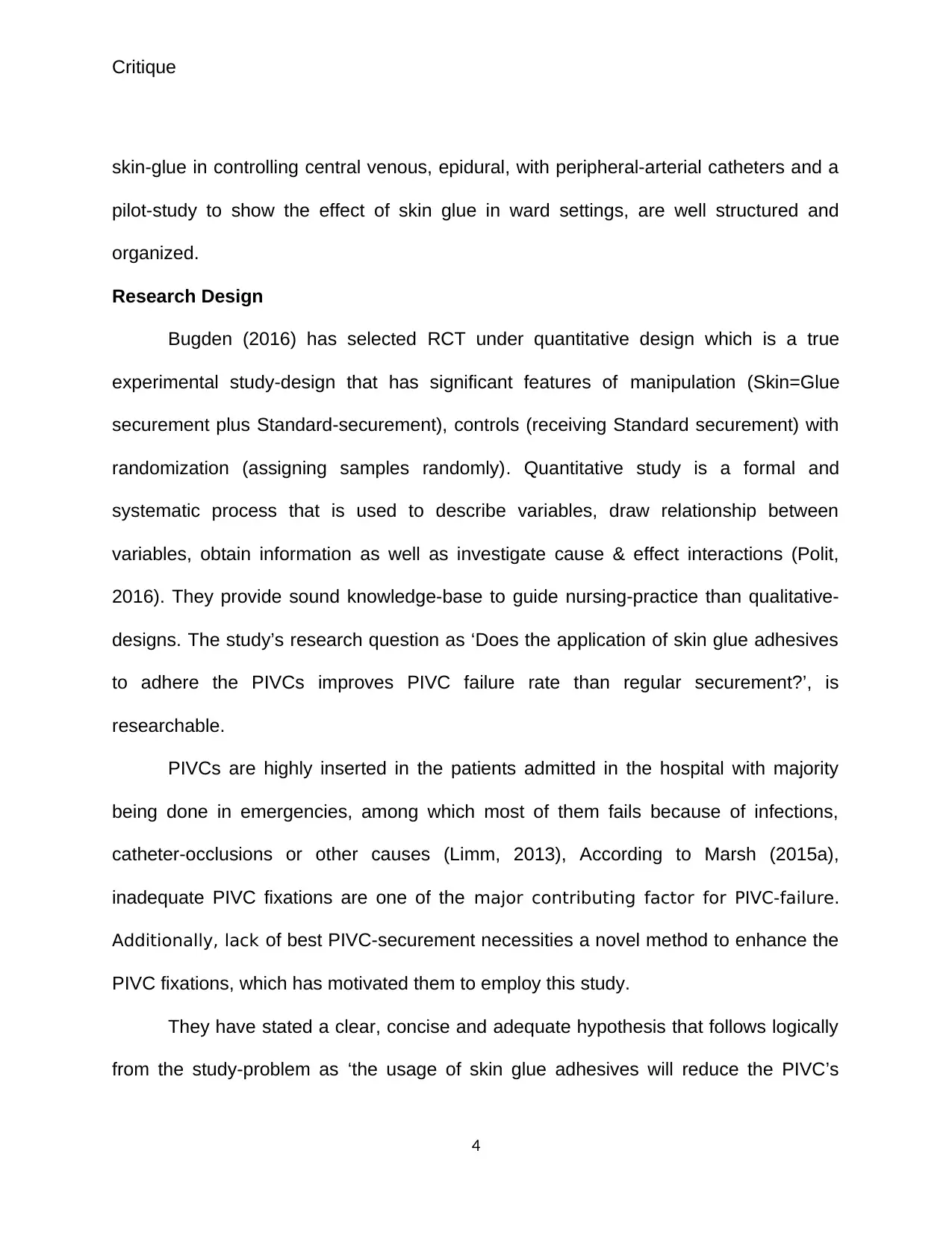
Critique
skin-glue in controlling central venous, epidural, with peripheral-arterial catheters and a
pilot-study to show the effect of skin glue in ward settings, are well structured and
organized.
Research Design
Bugden (2016) has selected RCT under quantitative design which is a true
experimental study-design that has significant features of manipulation (Skin=Glue
securement plus Standard-securement), controls (receiving Standard securement) with
randomization (assigning samples randomly). Quantitative study is a formal and
systematic process that is used to describe variables, draw relationship between
variables, obtain information as well as investigate cause & effect interactions (Polit,
2016). They provide sound knowledge-base to guide nursing-practice than qualitative-
designs. The study’s research question as ‘Does the application of skin glue adhesives
to adhere the PIVCs improves PIVC failure rate than regular securement?’, is
researchable.
PIVCs are highly inserted in the patients admitted in the hospital with majority
being done in emergencies, among which most of them fails because of infections,
catheter-occlusions or other causes (Limm, 2013), According to Marsh (2015a),
inadequate PIVC fixations are one of the major contributing factor for PIVC-failure.
Additionally, lack of best PIVC-securement necessities a novel method to enhance the
PIVC fixations, which has motivated them to employ this study.
They have stated a clear, concise and adequate hypothesis that follows logically
from the study-problem as ‘the usage of skin glue adhesives will reduce the PIVC’s
4
skin-glue in controlling central venous, epidural, with peripheral-arterial catheters and a
pilot-study to show the effect of skin glue in ward settings, are well structured and
organized.
Research Design
Bugden (2016) has selected RCT under quantitative design which is a true
experimental study-design that has significant features of manipulation (Skin=Glue
securement plus Standard-securement), controls (receiving Standard securement) with
randomization (assigning samples randomly). Quantitative study is a formal and
systematic process that is used to describe variables, draw relationship between
variables, obtain information as well as investigate cause & effect interactions (Polit,
2016). They provide sound knowledge-base to guide nursing-practice than qualitative-
designs. The study’s research question as ‘Does the application of skin glue adhesives
to adhere the PIVCs improves PIVC failure rate than regular securement?’, is
researchable.
PIVCs are highly inserted in the patients admitted in the hospital with majority
being done in emergencies, among which most of them fails because of infections,
catheter-occlusions or other causes (Limm, 2013), According to Marsh (2015a),
inadequate PIVC fixations are one of the major contributing factor for PIVC-failure.
Additionally, lack of best PIVC-securement necessities a novel method to enhance the
PIVC fixations, which has motivated them to employ this study.
They have stated a clear, concise and adequate hypothesis that follows logically
from the study-problem as ‘the usage of skin glue adhesives will reduce the PIVC’s
4
Paraphrase This Document
Need a fresh take? Get an instant paraphrase of this document with our AI Paraphraser
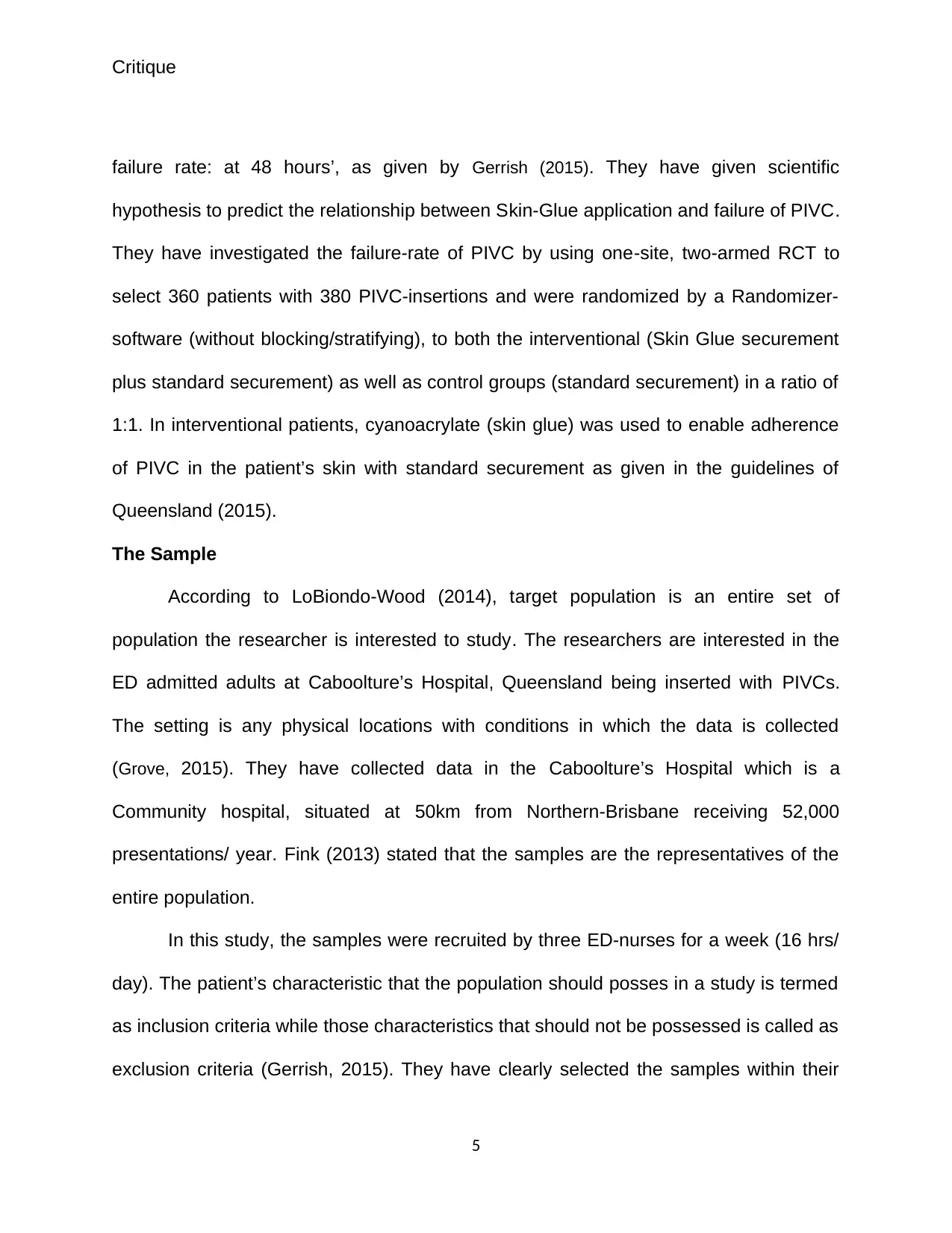
Critique
failure rate: at 48 hours’, as given by Gerrish (2015). They have given scientific
hypothesis to predict the relationship between Skin-Glue application and failure of PIVC.
They have investigated the failure-rate of PIVC by using one-site, two-armed RCT to
select 360 patients with 380 PIVC-insertions and were randomized by a Randomizer-
software (without blocking/stratifying), to both the interventional (Skin Glue securement
plus standard securement) as well as control groups (standard securement) in a ratio of
1:1. In interventional patients, cyanoacrylate (skin glue) was used to enable adherence
of PIVC in the patient’s skin with standard securement as given in the guidelines of
Queensland (2015).
The Sample
According to LoBiondo-Wood (2014), target population is an entire set of
population the researcher is interested to study. The researchers are interested in the
ED admitted adults at Caboolture’s Hospital, Queensland being inserted with PIVCs.
The setting is any physical locations with conditions in which the data is collected
(Grove, 2015). They have collected data in the Caboolture’s Hospital which is a
Community hospital, situated at 50km from Northern-Brisbane receiving 52,000
presentations/ year. Fink (2013) stated that the samples are the representatives of the
entire population.
In this study, the samples were recruited by three ED-nurses for a week (16 hrs/
day). The patient’s characteristic that the population should posses in a study is termed
as inclusion criteria while those characteristics that should not be possessed is called as
exclusion criteria (Gerrish, 2015). They have clearly selected the samples within their
5
failure rate: at 48 hours’, as given by Gerrish (2015). They have given scientific
hypothesis to predict the relationship between Skin-Glue application and failure of PIVC.
They have investigated the failure-rate of PIVC by using one-site, two-armed RCT to
select 360 patients with 380 PIVC-insertions and were randomized by a Randomizer-
software (without blocking/stratifying), to both the interventional (Skin Glue securement
plus standard securement) as well as control groups (standard securement) in a ratio of
1:1. In interventional patients, cyanoacrylate (skin glue) was used to enable adherence
of PIVC in the patient’s skin with standard securement as given in the guidelines of
Queensland (2015).
The Sample
According to LoBiondo-Wood (2014), target population is an entire set of
population the researcher is interested to study. The researchers are interested in the
ED admitted adults at Caboolture’s Hospital, Queensland being inserted with PIVCs.
The setting is any physical locations with conditions in which the data is collected
(Grove, 2015). They have collected data in the Caboolture’s Hospital which is a
Community hospital, situated at 50km from Northern-Brisbane receiving 52,000
presentations/ year. Fink (2013) stated that the samples are the representatives of the
entire population.
In this study, the samples were recruited by three ED-nurses for a week (16 hrs/
day). The patient’s characteristic that the population should posses in a study is termed
as inclusion criteria while those characteristics that should not be possessed is called as
exclusion criteria (Gerrish, 2015). They have clearly selected the samples within their
5
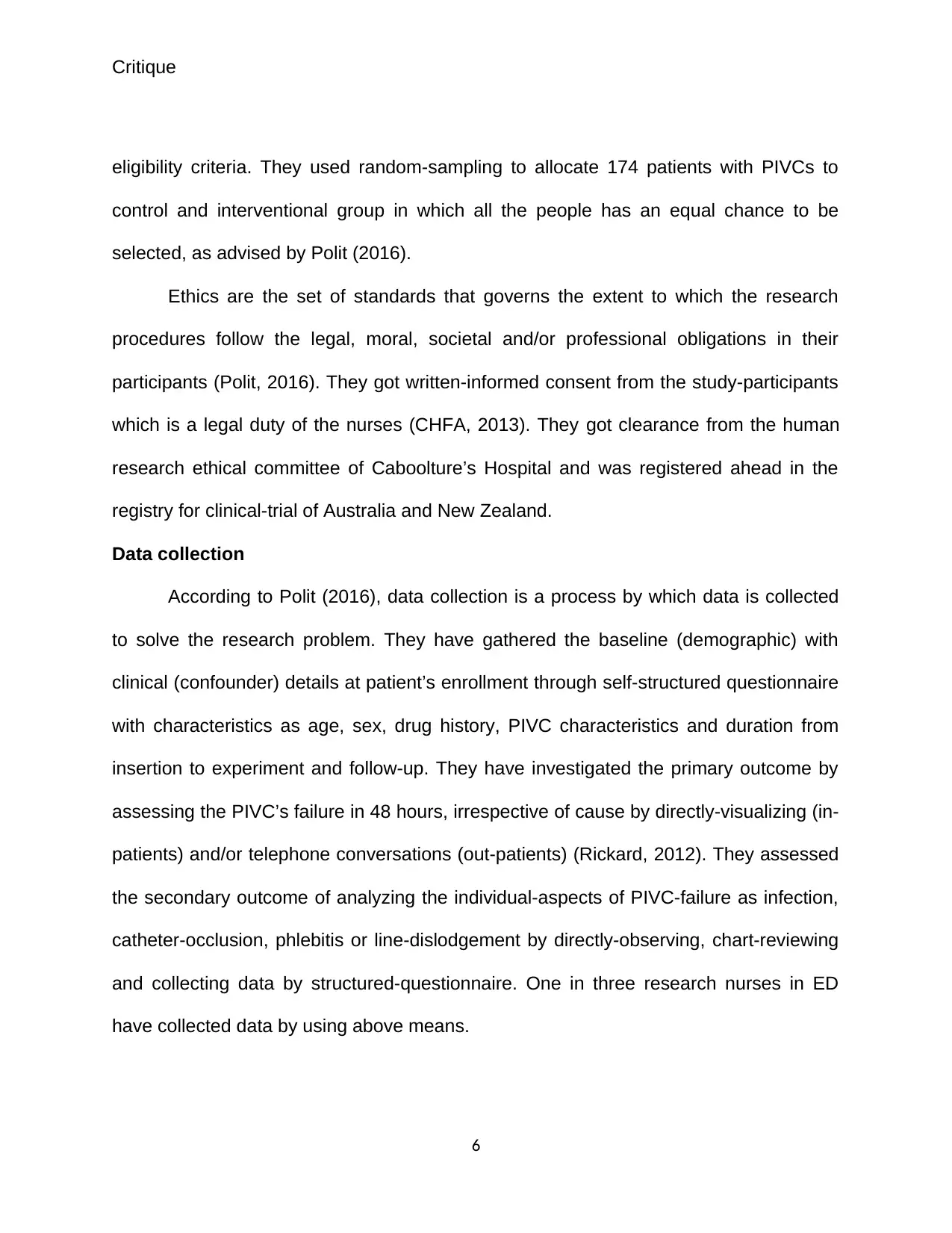
Critique
eligibility criteria. They used random-sampling to allocate 174 patients with PIVCs to
control and interventional group in which all the people has an equal chance to be
selected, as advised by Polit (2016).
Ethics are the set of standards that governs the extent to which the research
procedures follow the legal, moral, societal and/or professional obligations in their
participants (Polit, 2016). They got written-informed consent from the study-participants
which is a legal duty of the nurses (CHFA, 2013). They got clearance from the human
research ethical committee of Caboolture’s Hospital and was registered ahead in the
registry for clinical-trial of Australia and New Zealand.
Data collection
According to Polit (2016), data collection is a process by which data is collected
to solve the research problem. They have gathered the baseline (demographic) with
clinical (confounder) details at patient’s enrollment through self-structured questionnaire
with characteristics as age, sex, drug history, PIVC characteristics and duration from
insertion to experiment and follow-up. They have investigated the primary outcome by
assessing the PIVC’s failure in 48 hours, irrespective of cause by directly-visualizing (in-
patients) and/or telephone conversations (out-patients) (Rickard, 2012). They assessed
the secondary outcome of analyzing the individual-aspects of PIVC-failure as infection,
catheter-occlusion, phlebitis or line-dislodgement by directly-observing, chart-reviewing
and collecting data by structured-questionnaire. One in three research nurses in ED
have collected data by using above means.
6
eligibility criteria. They used random-sampling to allocate 174 patients with PIVCs to
control and interventional group in which all the people has an equal chance to be
selected, as advised by Polit (2016).
Ethics are the set of standards that governs the extent to which the research
procedures follow the legal, moral, societal and/or professional obligations in their
participants (Polit, 2016). They got written-informed consent from the study-participants
which is a legal duty of the nurses (CHFA, 2013). They got clearance from the human
research ethical committee of Caboolture’s Hospital and was registered ahead in the
registry for clinical-trial of Australia and New Zealand.
Data collection
According to Polit (2016), data collection is a process by which data is collected
to solve the research problem. They have gathered the baseline (demographic) with
clinical (confounder) details at patient’s enrollment through self-structured questionnaire
with characteristics as age, sex, drug history, PIVC characteristics and duration from
insertion to experiment and follow-up. They have investigated the primary outcome by
assessing the PIVC’s failure in 48 hours, irrespective of cause by directly-visualizing (in-
patients) and/or telephone conversations (out-patients) (Rickard, 2012). They assessed
the secondary outcome of analyzing the individual-aspects of PIVC-failure as infection,
catheter-occlusion, phlebitis or line-dislodgement by directly-observing, chart-reviewing
and collecting data by structured-questionnaire. One in three research nurses in ED
have collected data by using above means.
6
⊘ This is a preview!⊘
Do you want full access?
Subscribe today to unlock all pages.

Trusted by 1+ million students worldwide
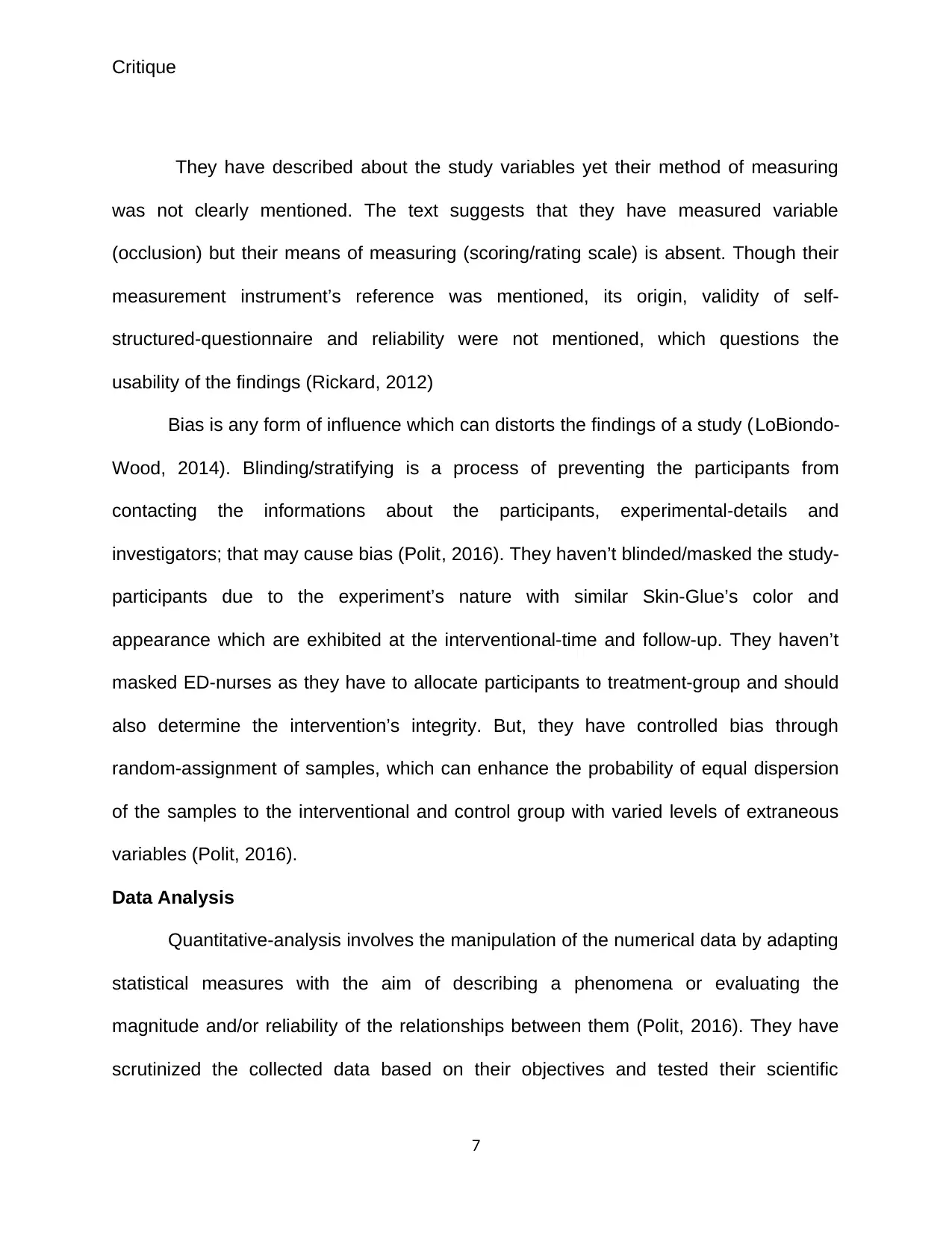
Critique
They have described about the study variables yet their method of measuring
was not clearly mentioned. The text suggests that they have measured variable
(occlusion) but their means of measuring (scoring/rating scale) is absent. Though their
measurement instrument’s reference was mentioned, its origin, validity of self-
structured-questionnaire and reliability were not mentioned, which questions the
usability of the findings (Rickard, 2012)
Bias is any form of influence which can distorts the findings of a study (LoBiondo-
Wood, 2014). Blinding/stratifying is a process of preventing the participants from
contacting the informations about the participants, experimental-details and
investigators; that may cause bias (Polit, 2016). They haven’t blinded/masked the study-
participants due to the experiment’s nature with similar Skin-Glue’s color and
appearance which are exhibited at the interventional-time and follow-up. They haven’t
masked ED-nurses as they have to allocate participants to treatment-group and should
also determine the intervention’s integrity. But, they have controlled bias through
random-assignment of samples, which can enhance the probability of equal dispersion
of the samples to the interventional and control group with varied levels of extraneous
variables (Polit, 2016).
Data Analysis
Quantitative-analysis involves the manipulation of the numerical data by adapting
statistical measures with the aim of describing a phenomena or evaluating the
magnitude and/or reliability of the relationships between them (Polit, 2016). They have
scrutinized the collected data based on their objectives and tested their scientific
7
They have described about the study variables yet their method of measuring
was not clearly mentioned. The text suggests that they have measured variable
(occlusion) but their means of measuring (scoring/rating scale) is absent. Though their
measurement instrument’s reference was mentioned, its origin, validity of self-
structured-questionnaire and reliability were not mentioned, which questions the
usability of the findings (Rickard, 2012)
Bias is any form of influence which can distorts the findings of a study (LoBiondo-
Wood, 2014). Blinding/stratifying is a process of preventing the participants from
contacting the informations about the participants, experimental-details and
investigators; that may cause bias (Polit, 2016). They haven’t blinded/masked the study-
participants due to the experiment’s nature with similar Skin-Glue’s color and
appearance which are exhibited at the interventional-time and follow-up. They haven’t
masked ED-nurses as they have to allocate participants to treatment-group and should
also determine the intervention’s integrity. But, they have controlled bias through
random-assignment of samples, which can enhance the probability of equal dispersion
of the samples to the interventional and control group with varied levels of extraneous
variables (Polit, 2016).
Data Analysis
Quantitative-analysis involves the manipulation of the numerical data by adapting
statistical measures with the aim of describing a phenomena or evaluating the
magnitude and/or reliability of the relationships between them (Polit, 2016). They have
scrutinized the collected data based on their objectives and tested their scientific
7
Paraphrase This Document
Need a fresh take? Get an instant paraphrase of this document with our AI Paraphraser
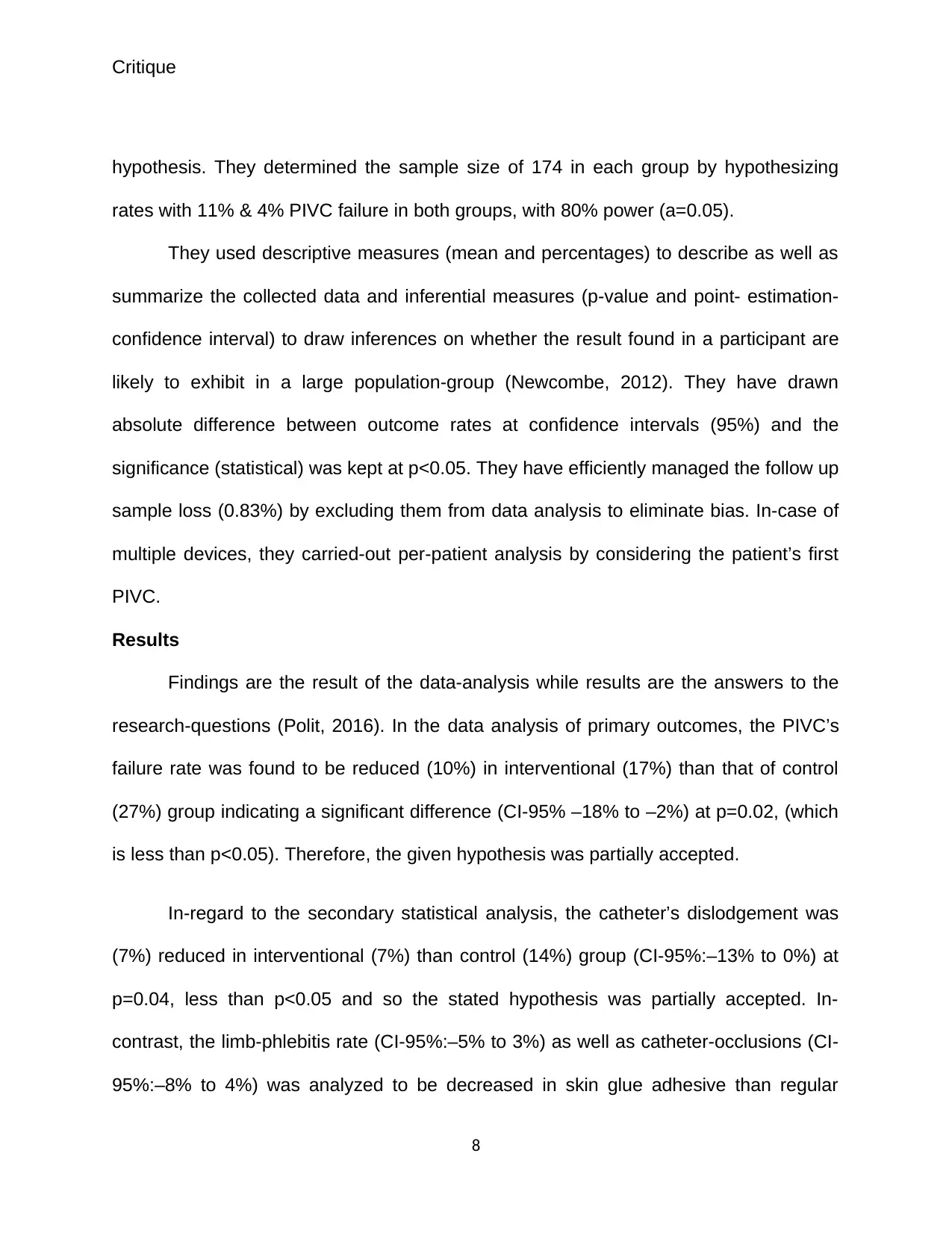
Critique
hypothesis. They determined the sample size of 174 in each group by hypothesizing
rates with 11% & 4% PIVC failure in both groups, with 80% power (a=0.05).
They used descriptive measures (mean and percentages) to describe as well as
summarize the collected data and inferential measures (p-value and point- estimation-
confidence interval) to draw inferences on whether the result found in a participant are
likely to exhibit in a large population-group (Newcombe, 2012). They have drawn
absolute difference between outcome rates at confidence intervals (95%) and the
significance (statistical) was kept at p<0.05. They have efficiently managed the follow up
sample loss (0.83%) by excluding them from data analysis to eliminate bias. In-case of
multiple devices, they carried-out per-patient analysis by considering the patient’s first
PIVC.
Results
Findings are the result of the data-analysis while results are the answers to the
research-questions (Polit, 2016). In the data analysis of primary outcomes, the PIVC’s
failure rate was found to be reduced (10%) in interventional (17%) than that of control
(27%) group indicating a significant difference (CI-95% –18% to –2%) at p=0.02, (which
is less than p<0.05). Therefore, the given hypothesis was partially accepted.
In-regard to the secondary statistical analysis, the catheter’s dislodgement was
(7%) reduced in interventional (7%) than control (14%) group (CI-95%:–13% to 0%) at
p=0.04, less than p<0.05 and so the stated hypothesis was partially accepted. In-
contrast, the limb-phlebitis rate (CI-95%:–5% to 3%) as well as catheter-occlusions (CI-
95%:–8% to 4%) was analyzed to be decreased in skin glue adhesive than regular
8
hypothesis. They determined the sample size of 174 in each group by hypothesizing
rates with 11% & 4% PIVC failure in both groups, with 80% power (a=0.05).
They used descriptive measures (mean and percentages) to describe as well as
summarize the collected data and inferential measures (p-value and point- estimation-
confidence interval) to draw inferences on whether the result found in a participant are
likely to exhibit in a large population-group (Newcombe, 2012). They have drawn
absolute difference between outcome rates at confidence intervals (95%) and the
significance (statistical) was kept at p<0.05. They have efficiently managed the follow up
sample loss (0.83%) by excluding them from data analysis to eliminate bias. In-case of
multiple devices, they carried-out per-patient analysis by considering the patient’s first
PIVC.
Results
Findings are the result of the data-analysis while results are the answers to the
research-questions (Polit, 2016). In the data analysis of primary outcomes, the PIVC’s
failure rate was found to be reduced (10%) in interventional (17%) than that of control
(27%) group indicating a significant difference (CI-95% –18% to –2%) at p=0.02, (which
is less than p<0.05). Therefore, the given hypothesis was partially accepted.
In-regard to the secondary statistical analysis, the catheter’s dislodgement was
(7%) reduced in interventional (7%) than control (14%) group (CI-95%:–13% to 0%) at
p=0.04, less than p<0.05 and so the stated hypothesis was partially accepted. In-
contrast, the limb-phlebitis rate (CI-95%:–5% to 3%) as well as catheter-occlusions (CI-
95%:–8% to 4%) was analyzed to be decreased in skin glue adhesive than regular
8
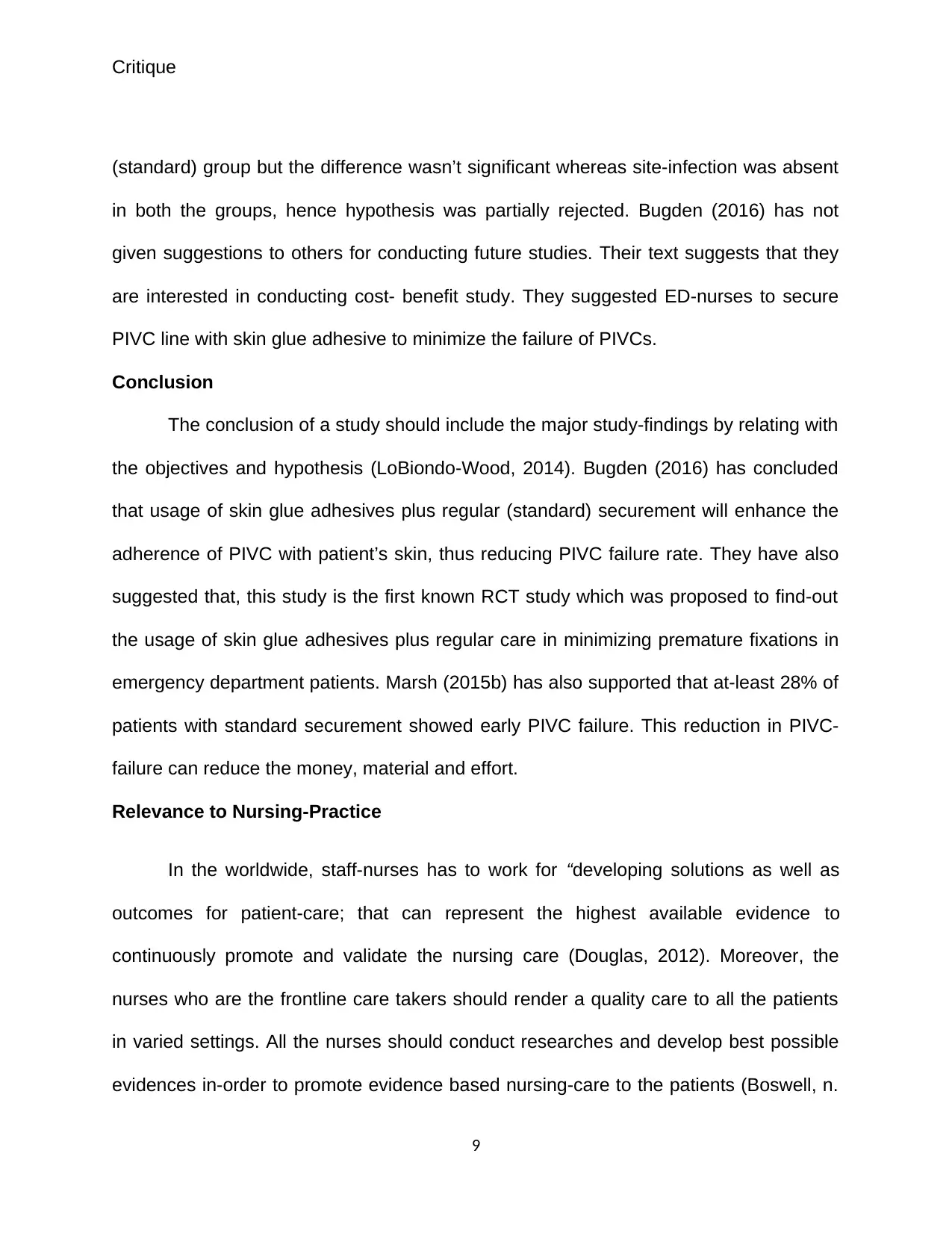
Critique
(standard) group but the difference wasn’t significant whereas site-infection was absent
in both the groups, hence hypothesis was partially rejected. Bugden (2016) has not
given suggestions to others for conducting future studies. Their text suggests that they
are interested in conducting cost- benefit study. They suggested ED-nurses to secure
PIVC line with skin glue adhesive to minimize the failure of PIVCs.
Conclusion
The conclusion of a study should include the major study-findings by relating with
the objectives and hypothesis (LoBiondo-Wood, 2014). Bugden (2016) has concluded
that usage of skin glue adhesives plus regular (standard) securement will enhance the
adherence of PIVC with patient’s skin, thus reducing PIVC failure rate. They have also
suggested that, this study is the first known RCT study which was proposed to find-out
the usage of skin glue adhesives plus regular care in minimizing premature fixations in
emergency department patients. Marsh (2015b) has also supported that at-least 28% of
patients with standard securement showed early PIVC failure. This reduction in PIVC-
failure can reduce the money, material and effort.
Relevance to Nursing-Practice
In the worldwide, staff-nurses has to work for “developing solutions as well as
outcomes for patient-care; that can represent the highest available evidence to
continuously promote and validate the nursing care (Douglas, 2012). Moreover, the
nurses who are the frontline care takers should render a quality care to all the patients
in varied settings. All the nurses should conduct researches and develop best possible
evidences in-order to promote evidence based nursing-care to the patients (Boswell, n.
9
(standard) group but the difference wasn’t significant whereas site-infection was absent
in both the groups, hence hypothesis was partially rejected. Bugden (2016) has not
given suggestions to others for conducting future studies. Their text suggests that they
are interested in conducting cost- benefit study. They suggested ED-nurses to secure
PIVC line with skin glue adhesive to minimize the failure of PIVCs.
Conclusion
The conclusion of a study should include the major study-findings by relating with
the objectives and hypothesis (LoBiondo-Wood, 2014). Bugden (2016) has concluded
that usage of skin glue adhesives plus regular (standard) securement will enhance the
adherence of PIVC with patient’s skin, thus reducing PIVC failure rate. They have also
suggested that, this study is the first known RCT study which was proposed to find-out
the usage of skin glue adhesives plus regular care in minimizing premature fixations in
emergency department patients. Marsh (2015b) has also supported that at-least 28% of
patients with standard securement showed early PIVC failure. This reduction in PIVC-
failure can reduce the money, material and effort.
Relevance to Nursing-Practice
In the worldwide, staff-nurses has to work for “developing solutions as well as
outcomes for patient-care; that can represent the highest available evidence to
continuously promote and validate the nursing care (Douglas, 2012). Moreover, the
nurses who are the frontline care takers should render a quality care to all the patients
in varied settings. All the nurses should conduct researches and develop best possible
evidences in-order to promote evidence based nursing-care to the patients (Boswell, n.
9
⊘ This is a preview!⊘
Do you want full access?
Subscribe today to unlock all pages.

Trusted by 1+ million students worldwide
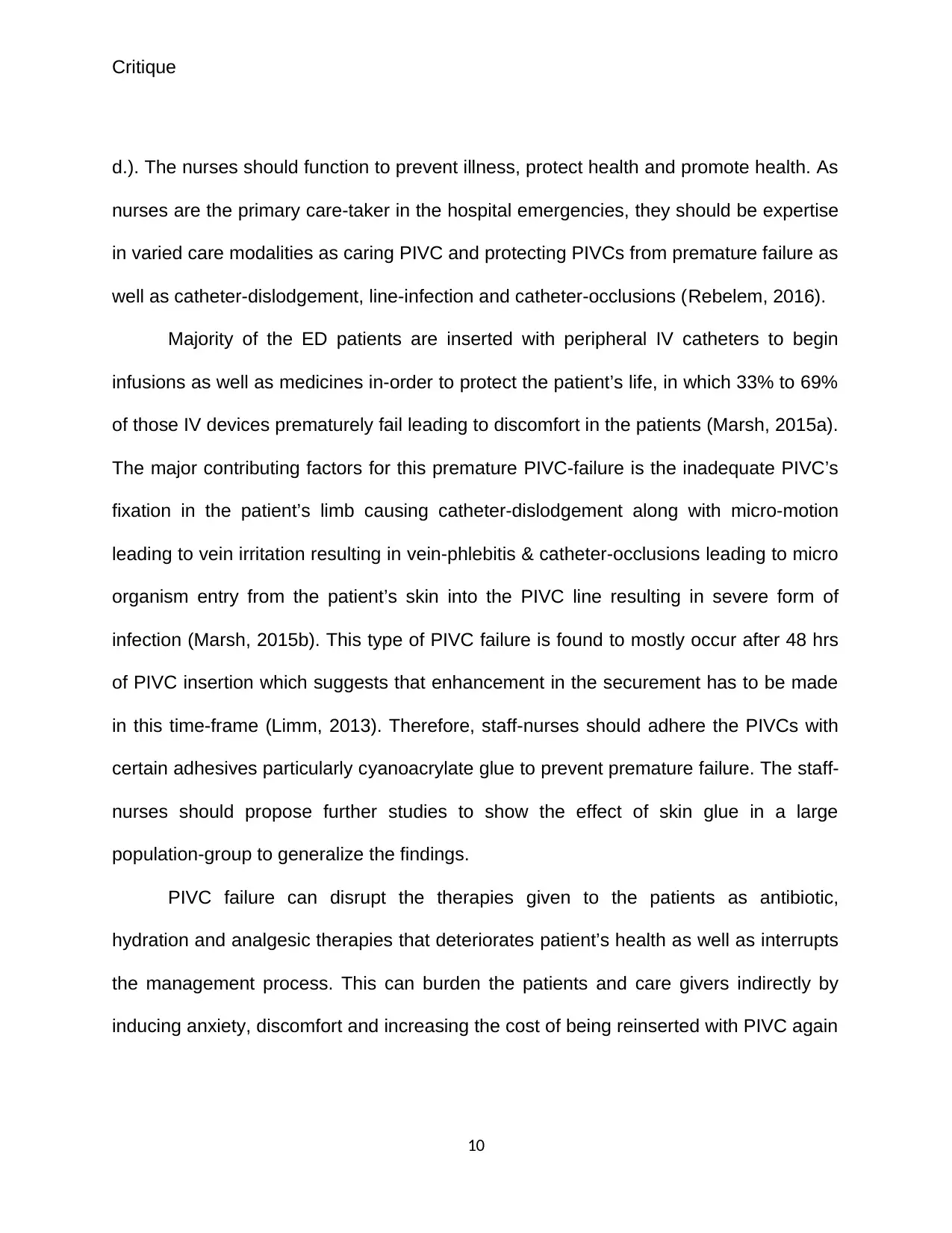
Critique
d.). The nurses should function to prevent illness, protect health and promote health. As
nurses are the primary care-taker in the hospital emergencies, they should be expertise
in varied care modalities as caring PIVC and protecting PIVCs from premature failure as
well as catheter-dislodgement, line-infection and catheter-occlusions (Rebelem, 2016).
Majority of the ED patients are inserted with peripheral IV catheters to begin
infusions as well as medicines in-order to protect the patient’s life, in which 33% to 69%
of those IV devices prematurely fail leading to discomfort in the patients (Marsh, 2015a).
The major contributing factors for this premature PIVC-failure is the inadequate PIVC’s
fixation in the patient’s limb causing catheter-dislodgement along with micro-motion
leading to vein irritation resulting in vein-phlebitis & catheter-occlusions leading to micro
organism entry from the patient’s skin into the PIVC line resulting in severe form of
infection (Marsh, 2015b). This type of PIVC failure is found to mostly occur after 48 hrs
of PIVC insertion which suggests that enhancement in the securement has to be made
in this time-frame (Limm, 2013). Therefore, staff-nurses should adhere the PIVCs with
certain adhesives particularly cyanoacrylate glue to prevent premature failure. The staff-
nurses should propose further studies to show the effect of skin glue in a large
population-group to generalize the findings.
PIVC failure can disrupt the therapies given to the patients as antibiotic,
hydration and analgesic therapies that deteriorates patient’s health as well as interrupts
the management process. This can burden the patients and care givers indirectly by
inducing anxiety, discomfort and increasing the cost of being reinserted with PIVC again
10
d.). The nurses should function to prevent illness, protect health and promote health. As
nurses are the primary care-taker in the hospital emergencies, they should be expertise
in varied care modalities as caring PIVC and protecting PIVCs from premature failure as
well as catheter-dislodgement, line-infection and catheter-occlusions (Rebelem, 2016).
Majority of the ED patients are inserted with peripheral IV catheters to begin
infusions as well as medicines in-order to protect the patient’s life, in which 33% to 69%
of those IV devices prematurely fail leading to discomfort in the patients (Marsh, 2015a).
The major contributing factors for this premature PIVC-failure is the inadequate PIVC’s
fixation in the patient’s limb causing catheter-dislodgement along with micro-motion
leading to vein irritation resulting in vein-phlebitis & catheter-occlusions leading to micro
organism entry from the patient’s skin into the PIVC line resulting in severe form of
infection (Marsh, 2015b). This type of PIVC failure is found to mostly occur after 48 hrs
of PIVC insertion which suggests that enhancement in the securement has to be made
in this time-frame (Limm, 2013). Therefore, staff-nurses should adhere the PIVCs with
certain adhesives particularly cyanoacrylate glue to prevent premature failure. The staff-
nurses should propose further studies to show the effect of skin glue in a large
population-group to generalize the findings.
PIVC failure can disrupt the therapies given to the patients as antibiotic,
hydration and analgesic therapies that deteriorates patient’s health as well as interrupts
the management process. This can burden the patients and care givers indirectly by
inducing anxiety, discomfort and increasing the cost of being reinserted with PIVC again
10
Paraphrase This Document
Need a fresh take? Get an instant paraphrase of this document with our AI Paraphraser
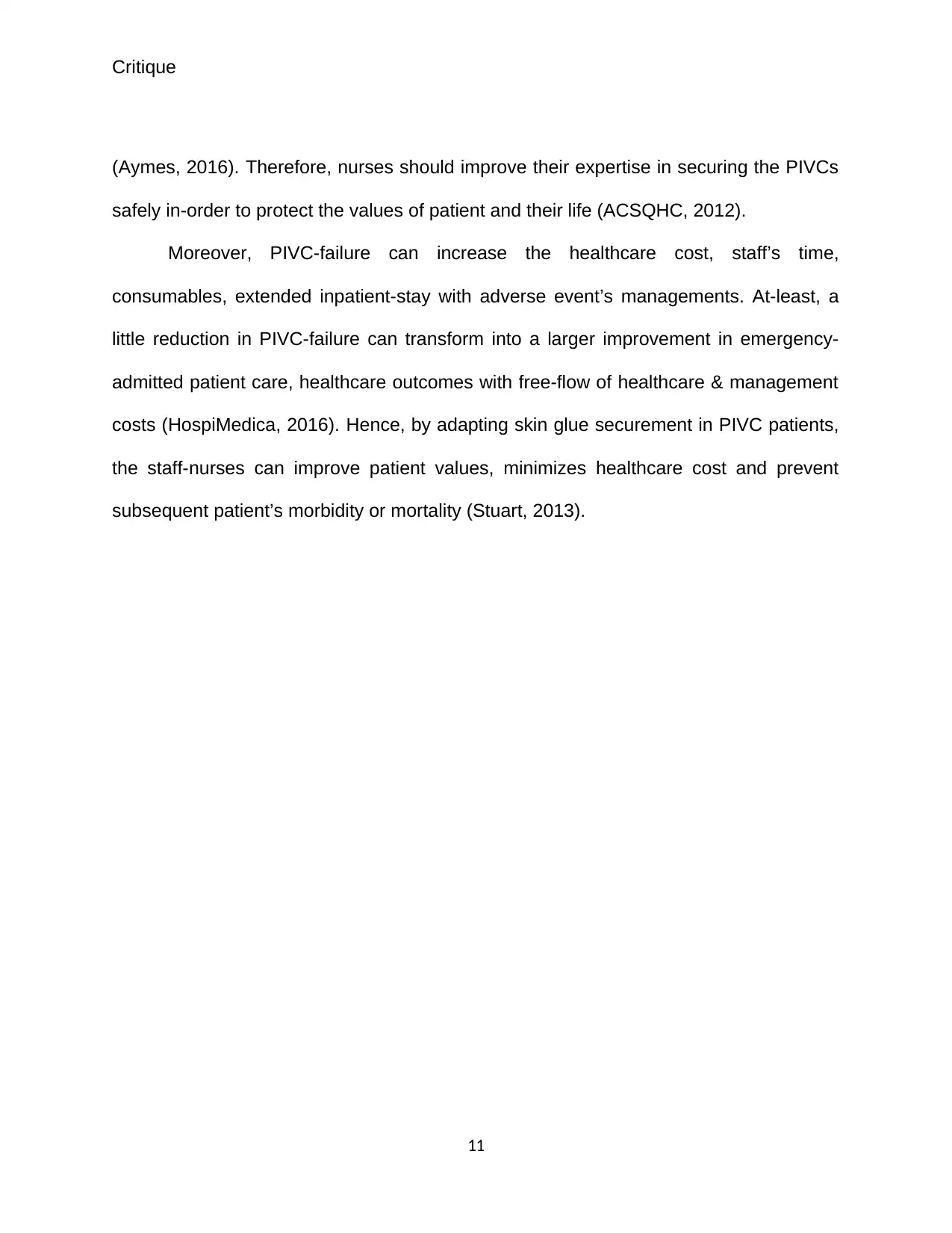
Critique
(Aymes, 2016). Therefore, nurses should improve their expertise in securing the PIVCs
safely in-order to protect the values of patient and their life (ACSQHC, 2012).
Moreover, PIVC-failure can increase the healthcare cost, staff’s time,
consumables, extended inpatient-stay with adverse event’s managements. At-least, a
little reduction in PIVC-failure can transform into a larger improvement in emergency-
admitted patient care, healthcare outcomes with free-flow of healthcare & management
costs (HospiMedica, 2016). Hence, by adapting skin glue securement in PIVC patients,
the staff-nurses can improve patient values, minimizes healthcare cost and prevent
subsequent patient’s morbidity or mortality (Stuart, 2013).
11
(Aymes, 2016). Therefore, nurses should improve their expertise in securing the PIVCs
safely in-order to protect the values of patient and their life (ACSQHC, 2012).
Moreover, PIVC-failure can increase the healthcare cost, staff’s time,
consumables, extended inpatient-stay with adverse event’s managements. At-least, a
little reduction in PIVC-failure can transform into a larger improvement in emergency-
admitted patient care, healthcare outcomes with free-flow of healthcare & management
costs (HospiMedica, 2016). Hence, by adapting skin glue securement in PIVC patients,
the staff-nurses can improve patient values, minimizes healthcare cost and prevent
subsequent patient’s morbidity or mortality (Stuart, 2013).
11
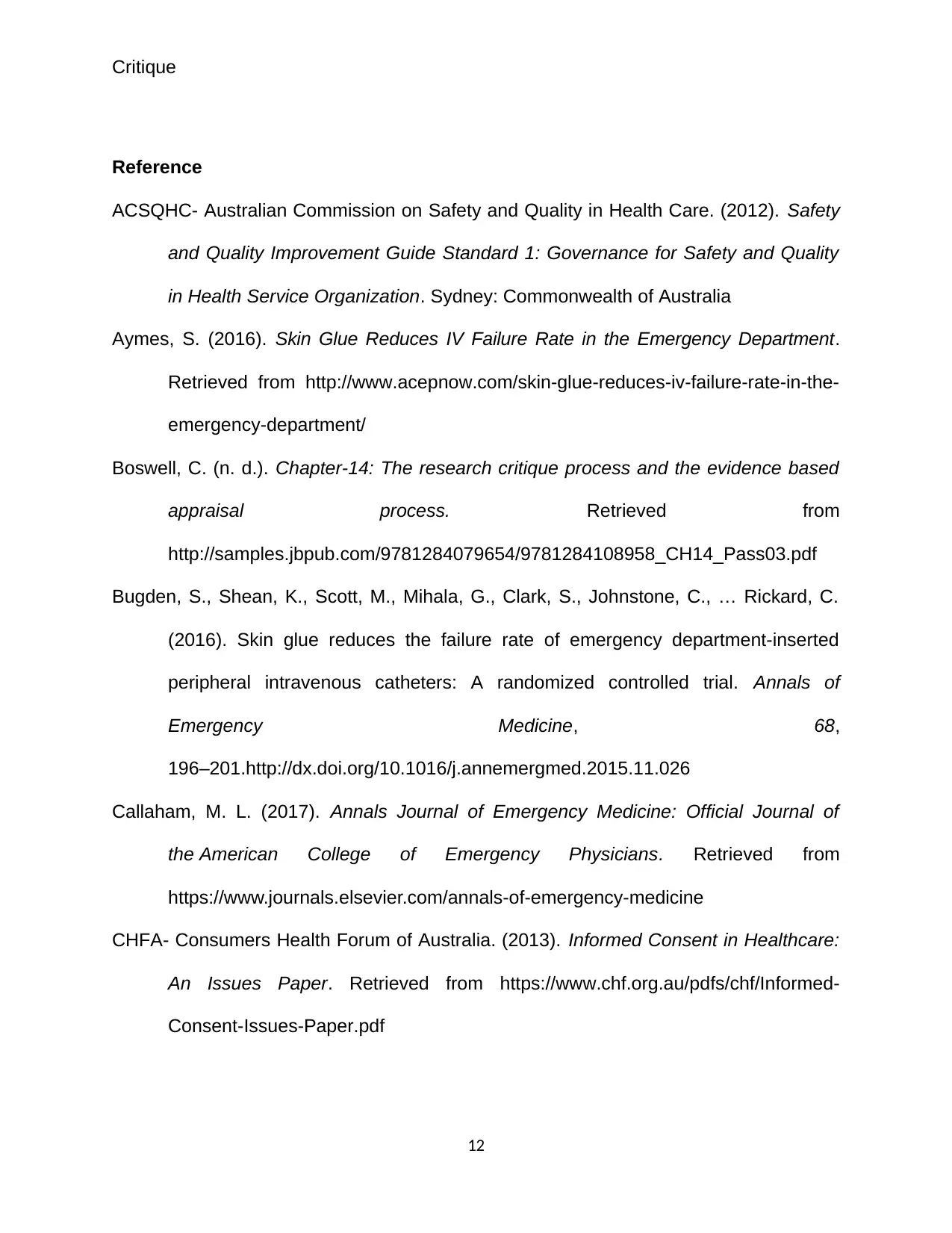
Critique
Reference
ACSQHC- Australian Commission on Safety and Quality in Health Care. (2012). Safety
and Quality Improvement Guide Standard 1: Governance for Safety and Quality
in Health Service Organization. Sydney: Commonwealth of Australia
Aymes, S. (2016). Skin Glue Reduces IV Failure Rate in the Emergency Department.
Retrieved from http://www.acepnow.com/skin-glue-reduces-iv-failure-rate-in-the-
emergency-department/
Boswell, C. (n. d.). Chapter-14: The research critique process and the evidence based
appraisal process. Retrieved from
http://samples.jbpub.com/9781284079654/9781284108958_CH14_Pass03.pdf
Bugden, S., Shean, K., Scott, M., Mihala, G., Clark, S., Johnstone, C., … Rickard, C.
(2016). Skin glue reduces the failure rate of emergency department-inserted
peripheral intravenous catheters: A randomized controlled trial. Annals of
Emergency Medicine, 68,
196–201.http://dx.doi.org/10.1016/j.annemergmed.2015.11.026
Callaham, M. L. (2017). Annals Journal of Emergency Medicine: Official Journal of
the American College of Emergency Physicians. Retrieved from
https://www.journals.elsevier.com/annals-of-emergency-medicine
CHFA- Consumers Health Forum of Australia. (2013). Informed Consent in Healthcare:
An Issues Paper. Retrieved from https://www.chf.org.au/pdfs/chf/Informed-
Consent-Issues-Paper.pdf
12
Reference
ACSQHC- Australian Commission on Safety and Quality in Health Care. (2012). Safety
and Quality Improvement Guide Standard 1: Governance for Safety and Quality
in Health Service Organization. Sydney: Commonwealth of Australia
Aymes, S. (2016). Skin Glue Reduces IV Failure Rate in the Emergency Department.
Retrieved from http://www.acepnow.com/skin-glue-reduces-iv-failure-rate-in-the-
emergency-department/
Boswell, C. (n. d.). Chapter-14: The research critique process and the evidence based
appraisal process. Retrieved from
http://samples.jbpub.com/9781284079654/9781284108958_CH14_Pass03.pdf
Bugden, S., Shean, K., Scott, M., Mihala, G., Clark, S., Johnstone, C., … Rickard, C.
(2016). Skin glue reduces the failure rate of emergency department-inserted
peripheral intravenous catheters: A randomized controlled trial. Annals of
Emergency Medicine, 68,
196–201.http://dx.doi.org/10.1016/j.annemergmed.2015.11.026
Callaham, M. L. (2017). Annals Journal of Emergency Medicine: Official Journal of
the American College of Emergency Physicians. Retrieved from
https://www.journals.elsevier.com/annals-of-emergency-medicine
CHFA- Consumers Health Forum of Australia. (2013). Informed Consent in Healthcare:
An Issues Paper. Retrieved from https://www.chf.org.au/pdfs/chf/Informed-
Consent-Issues-Paper.pdf
12
⊘ This is a preview!⊘
Do you want full access?
Subscribe today to unlock all pages.

Trusted by 1+ million students worldwide
1 out of 14
Related Documents
Your All-in-One AI-Powered Toolkit for Academic Success.
+13062052269
info@desklib.com
Available 24*7 on WhatsApp / Email
![[object Object]](/_next/static/media/star-bottom.7253800d.svg)
Unlock your academic potential
Copyright © 2020–2025 A2Z Services. All Rights Reserved. Developed and managed by ZUCOL.





